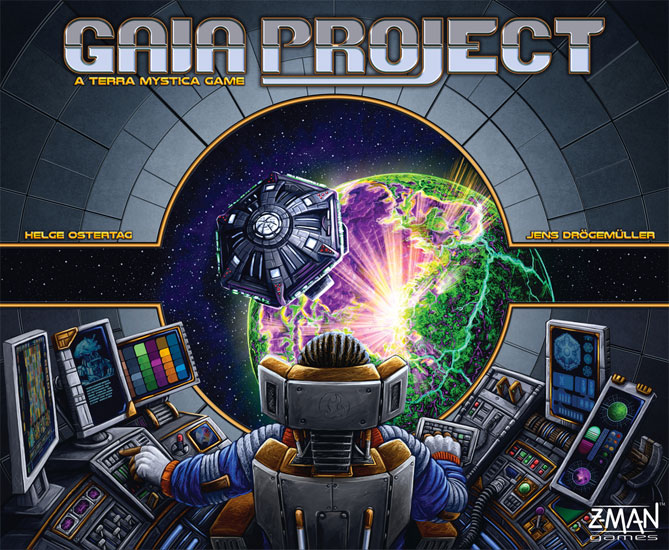

Yet Gaia Project both is and isn’t just Terra Mystica in space. Gaia Project clearly builds on the model of Terra Mystica, one of the highest-ranked board games on Board Game Geek and also one of my top ten favorite games. Players score end-game points for how far they’ve climbed up the technology tracks, for leftover resources, and for their position in the end-game scoring objectives. Players earn points primarily by forming federations (linking their buildings on the board), climbing up technology tracks and taking technology tiles, working toward the end-game objectives, and scoring the round’s bonus. Each round, a new scoring opportunity is available to players that rewards players for doing something during the round (for example, climbing a technology track, placing a mine on a Gaia planet, or upgrading to their planetary institute).

The terraforming track makes it cheaper to make planets inhabitable the navigation track extends a race’s range for colonization the artificial intelligence track rewards players with QICs the Gaia Project track allows players to use Gaia Projects the economy track boosts players’ income and the research track boosts a player’s knowledge, which can be used to move up technology tracks. There are six technology tracks in Gaia Project, which grant players abilities the farther they climb them. The score track goes around the perimeter. The technology board with technology tiles and tracks. There are also purple “Transdim” planets that are uninhabitable without using the titular Gaia Projects. Most planets are differently terraformable for each race (that is, each race has planet types that are more and less accommodating to them), but green Gaia planets are equally terraformable for each race. (Technology tiles advance players on technology tracks, which unlock new abilities for the player, and give them either one-time or ongoing bonuses.) There are also science buildings, which grant new technology tiles to the player. Each race has a “planetary institute,” which unlocks a unique power for the race when the player upgrades to it.
Youtube gaia project review upgrade#
If players want to place their bigger and better buildings on the board, they must upgrade their mines to trading stations and then upgrade their trading stations into other buildings. In Gaia Project, mines are the only new buildings that may be built on planets, and in order to build on a new planet, the planet must be in range and the player must first terraform it to fit their race’s unique needs. Players charge their power cycle through income and by being in close proximity when other players build or upgrade. Each player also has a separate power cycle of renewable energy that can be used to buy the four main resources in the game or to take special actions on the board. Players have to carefully manage their resources to accomplish their goals. There are four main resources in the game: ore, credits, knowledge, and “quantum intelligence cubes” (or QICs).

On a turn, there are eight possible actions: The bulk of the game happens during the action phase, when players take actions, one per turn, in turn order until every player passes. In the Gaia Project phase, players’ Gaia Projects transform planets. In income, players get resources based on which buildings they have on the board, their technology tiles, and certain technology tracks. A round in Gaia Project consists of four phases: income, Gaia Project, actions, and cleanup. (Note that all pictures in this review are provided by Alex, game is played over six rounds. The Terrans faction board in Gaia Project. Players set their buildings on their individual faction boards, choose starting locations on the main board, and in reverse turn order choose a round booster for the first round. A random advanced technology is assigned to each technology track, two end-game scoring conditions are randomly chosen, one round-scoring bonus tile is randomly assigned to each round, and round boosters are randomly chosen based on the number of players. The modular board tiles are arranged, and the technology tiles are randomly assigned to the nine spaces on the technology board. To begin, each player receives a unique alien race, represented by a faction board. Players control unique alien races and try to colonize the galaxy with their buildings. Gaia Project is a complex Euro game for two to four players. There are benefits to being close neighbors, but it’s harder to snatch the planet you want when you’re that close. The problem that’s harder to fix is just how small the galaxy is, and just how many other alien races there are. Your alien race is getting the expansionist itch, so it’s time to take to the stars! Unfortunately, there aren’t many planets that are well-suited for your race’s unique needs, but it’s nothing a little terraforming can’t fix.


 0 kommentar(er)
0 kommentar(er)
